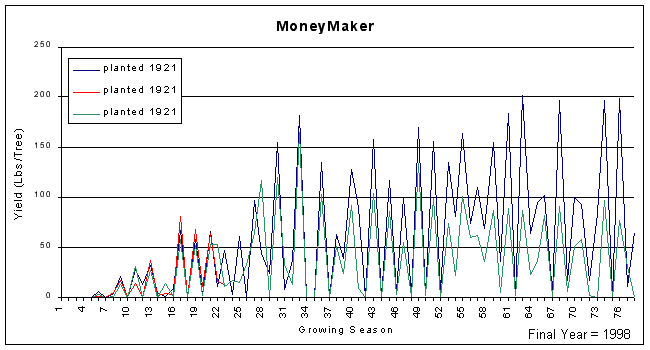MoneyMaker

Average nut quality of test trees.
| # Nuts / lb. | % Kernel | Kernel quality breakdown | Specific gravity | ||
| % Fancy | % Standard | % Amber | |||
| 68 | 44% | 6% | 32% | 7% | .78 |
History
The original tree of the Moneymaker variety is was grown by Mr. S. H. James, Mound, La., from nuts planted by him about 1885.
Comments
*Note: This is an older cultivar planted in the Old Variety Test at the Tifton Campus. Trees were planted decades ago when care was very different than it is now, and trees received much less care, so production data will reflect this fact. Trees began receiving insecticides in 1962, fungicides in 1970, nitrogen in 1962, and drip irrigation in 1975. The data for this cultivar was collected by several individuals, but the bulk of the data and the comments are from my predecessor Dr. Ray Worley. This information was originally published here: Worley and Mullinix, 1997.
'Moneymaker' is a controversial old cultivar with good yield, appearing among the top four yielders at age 45 and several times thereafter. This round nut has a thick shell and low percent kernel (44), but is usually well filled and has a high specific gravity. Its early maturity in the fall adapts it to the early holiday specialty market. Shellers would discount it for its low percent kernel and dark kernel color. The tree seems to be a pretty good keeper. The canopy is very open due to wide spacing of leaflets on the rachis. This allows good spray penetration. The alternate bearing cycle is pronounced and is a definite problem with this cultivar. Among older cultivars 'Moneymaker' has a very early harvest date. However, with newer cultivars like 'Pawnee' this advantage has diminished. Kernel quality is not comparable to more modern cultivars. 'Moneymaker' is not recommended but mature trees can be profitable in some situations.
Production record of test trees beginning in year planted
'Moneymaker' production from the Old Variety Test. Each colored line represents the yearly production in pounds of nuts from an individual tree beginning the year planted.
Alternate Bearing Intensity* = 0.68
*Computed from mature trees using data from years after trees began receiving fertilizer and pesticide sprays.

